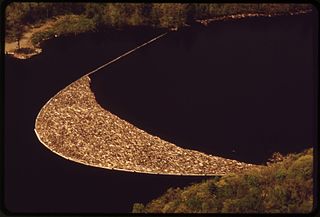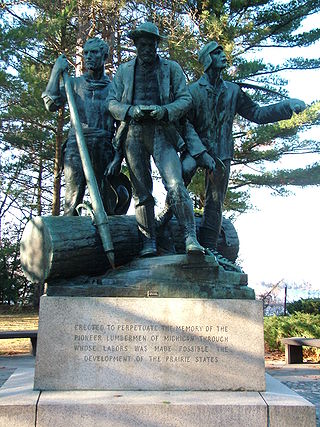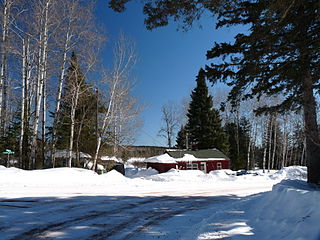
In the United States, a timber pirate is a pirate engaged in the illegal logging industry.

In the United States, a timber pirate is a pirate engaged in the illegal logging industry.
The term probably originated during the Timber Rebellion in 1853, when criminals mainly from the western Great Lakes region preyed on Michigan's government-owned supplies of lumber. When the government responded by confiscating loads of wood their owners and the so-called timber pirates revolted. The pirates assembled and burned a group of boats loaded with the stolen wood in the most serious incident of the conflict. Following that a series of naval operations by the United States Navy warship USS Michigan led to the capture of many rebels and successfully put an end to the revolt.
Timber pirates continued to thrive in the Great Lakes for several years afterward though and at the same time river pirates began operating on the upper Mississippi River and its tributaries. The American navy also launched another separate operation against timber pirates on the Calcasieu River of Louisiana. [1] In the early 20th century, those who engaged in New Mexico's illegal logging industry were called timber pirates. [2]

Lumber is wood that has been processed into uniform and useful sizes, including beams and planks or boards. Lumber is mainly used for construction framing, as well as finishing. Lumber has many uses beyond home building. Lumber is sometimes referred to as timber in England, Australia and New Zealand, while in most parts of the world the term timber refers specifically to unprocessed wood fiber, such as cut logs or standing trees that have yet to be cut.

Logging is the process of cutting, processing, and moving trees to a location for transport. It may include skidding, on-site processing, and loading of trees or logs onto trucks or skeleton cars. In forestry, the term logging is sometimes used narrowly to describe the logistics of moving wood from the stump to somewhere outside the forest, usually a sawmill or a lumber yard. In common usage, however, the term may cover a range of forestry or silviculture activities.

Lumberjacks are mostly North American workers in the logging industry who perform the initial harvesting and transport of trees for ultimate processing into forest products. The term usually refers to loggers in the era when trees were felled using hand tools and dragged by oxen to rivers.

Illegal logging is the harvest, transportation, purchase, or sale of timber in violation of laws. The harvesting procedure itself may be illegal, including using corrupt means to gain access to forests; extraction without permission, or from a protected area; the cutting down of protected species; or the extraction of timber in excess of agreed limits. Illegal logging is a driving force for a number of environmental issues such as deforestation, soil erosion and biodiversity loss which can drive larger-scale environmental crises such as climate change and other forms of environmental degradation.

A log boom is a barrier placed in a river, designed to collect and or contain floating logs timbered from nearby forests. The term is also used as a place where logs were collected into booms, as at the mouth of a river. With several firms driving on the same stream, it was necessary to direct the logs to their owner's respective booms, with each log identified by its own patented timber mark. One of the most well known logbooms was in Williamsport, Pennsylvania, along the Susquehanna River. The development and completion of that specific log boom in 1851 made Williamsport the "Lumber Capital of the World".
Pequaming is an unincorporated community in L'Anse Township of Baraga County in the U.S. state of Michigan. It is located on a narrow point of land that juts into Keweenaw Bay. Although still partially inhabited, Pequaming is one of the largest ghost towns in the Upper Peninsula of Michigan.

Lumberman's Monument is a monument dedicated to the workers of the early logging industry in Michigan. Standing at 14 feet, the bronze statue features a log surrounded by three figures: a timber cruiser holding a compass, a sawyer with his saw slung over his shoulder, and a river rat resting his peavey on the ground. The granite base of the statue is engraved with a memorial that reads "Erected to perpetuate the memory of the pioneer lumbermen of Michigan through whose labors was made possible the development of the prairie states." It is also inscribed with the names of the logging families who dedicated their time and efforts to the industry in the area. It was built in 1931, dedicated in 1932 and is managed by the USDA Forest Service. It is located in the northeastern part of the Lower Peninsula of Michigan along the Au Sable River within Huron-Manistee National Forests. Access to the park is on River Road, which intersects M-65 west of Oscoda, Michigan. Monument Road, from East Tawas, also leads directly to the monument, which is in Oscoda Township in Iosco County. The monument is part of the River Road Scenic Byway, a 22-mile (35 km) drive between Oscoda and South Branch that runs parallel with the beautiful Au Sable River. It is a designated National Scenic Byway.
The Russian forestry industry is a set of Russian industries related to wood harvesting and processing. As one of the oldest sectors in the country's economy, Russia's timber industry continues to bring in about $20 billion per year. Russia has more than a fifth of the world's forests, making it the largest forest country in the world. According to data for 2015, the total forest area has exceeded 885 million hectares, representing 45% of the total area of the country. The stock of wood in the area was 82 billion cubic meters.

Buffalo City was a logging and moonshine town in East Lake Township, Dare County, North Carolina, United States. It was on the mainland, 19 miles (31 km) west of Manteo near present-day Manns Harbor. The marshy land where Buffalo City once stood, near U.S. 64, is now part of the Alligator River National Wildlife Refuge. The town's history lasted approximately 80 years from the 1870s to 1950s, but at one time Buffalo City's population of 3,000 in the early 20th century made it the largest community in Dare County. A hotel, post office, schoolhouse, general store, 100 miles (160 km) of railroad track and rows of homes once stood on the now-abandoned area. Today, the only remnants of the ghost town include a road sign, rusted rails and building debris now overgrown with weeds.

A forest railway, forest tram, timber line, logging railway or logging railroad is a mode of railway transport which is used for forestry tasks, primarily the transportation of felled logs to sawmills or railway stations.

Dan Seavey, also known as "Roaring" Dan Seavey, was a sailor, fisherman, farmer, saloon keeper, prospector, U.S. marshal, thief, poacher, smuggler, hijacker, procurer, and timber pirate in Wisconsin and Michigan and on the Great Lakes in the late 19th to early 20th century.

The Great Lakes Patrol was carried out by American naval forces, beginning in 1844, mainly to suppress criminal activity and to protect the maritime border with Canada. A small force of United States Navy, Coast Guard, and Revenue Service ships served in the Great Lakes throughout these operations. Through the decades, they were involved in several incidents with pirates and rebels.

The Ottawa River timber trade, also known as the Ottawa Valley timber trade or Ottawa River lumber trade, was the nineteenth century production of wood products by Canada on areas of the Ottawa River and the regions of the Ottawa Valley and western Quebec, destined for British and American markets. It was the major industry of the historical colonies of Upper Canada and Lower Canada and it created an entrepreneur known as a lumber baron. The trade in squared timber and later sawed lumber led to population growth and prosperity to communities in the Ottawa Valley, especially the city of Bytown. The product was chiefly red and white pine.The Ottawa River being conveniently located with access via the St. Lawrence River, was a valuable region due to its great pine forests surpassing any others nearby. The industry lasted until around 1900 as both markets and supplies decreased, it was then reoriented to the production of wood pulp which continued until the late 1990s and early 2000s.

Morse is an unincorporated community located in the town of Gordon, Ashland County, Wisconsin, United States. Morse is located along the Bad River 7.5 miles (12.1 km) south-southeast of Mellen.

The history of the lumber industry in the united states spans from the precolonial period of British timber speculation, subsequent British colonization, and American development into the twenty-first century. Following the near eradication of domestic timber on the British Isles, the abundance of old-growth forests in the New World posed an attractive alternative to importing choice timber from the Baltic via the narrow straits and channels between Denmark and Sweden. The easily available timber proved an incredible resource to early settlers, with both domestic consumption and overseas trade fueling demand. The industry expanded rapidly as Americans logged their way across the country. In this pursuit, millions of indigenous peoples were murdered, displaced, and enslaved for the purpose of the timber industry.

The Hume-Bennett Lumber Company was a logging operation in the Sequoia National Forest in the late 19th and early 20th centuries. The company and its predecessors were known for building the world's longest log flume and the first multiple-arch hydroelectric dam. However, the company also engaged in destructive clearcutting logging practices, cutting down 8,000 giant sequoias in Converse Basin in a decade-long event that has been described as "the greatest orgy of destructive lumbering in the history of the world."
The wood industry or timber industry is the industry concerned with forestry, logging, timber trade, and the production of primary forest products and wood products and secondary products like wood pulp for the pulp and paper industry. Some of the largest producers are also among the biggest owners of timberland. The wood industry has historically been and continues to be an important sector in many economies.
The Pas Lumber Company was a forestry company that owned and operated several sawmills and logging operations in Manitoba, Saskatchewan, and British Columbia.

Consolidated Timber Company was an American lumber company that operated a large sawmill near Glenwood, Oregon, circa 1936–1946.

The Sugar Pine Lumber Company was an early 20th century logging operation and railroad in the Sierra Nevada. Unable to secure water rights to build a log flume, the company operated the “crookedest railroad ever built." They later developed the Minarets-type locomotive, the largest and most powerful saddle tank locomotive ever made. The company was also a pioneer in the electrification of logging where newly plentiful hydroelectric power replaced the widespread use of steam engines.